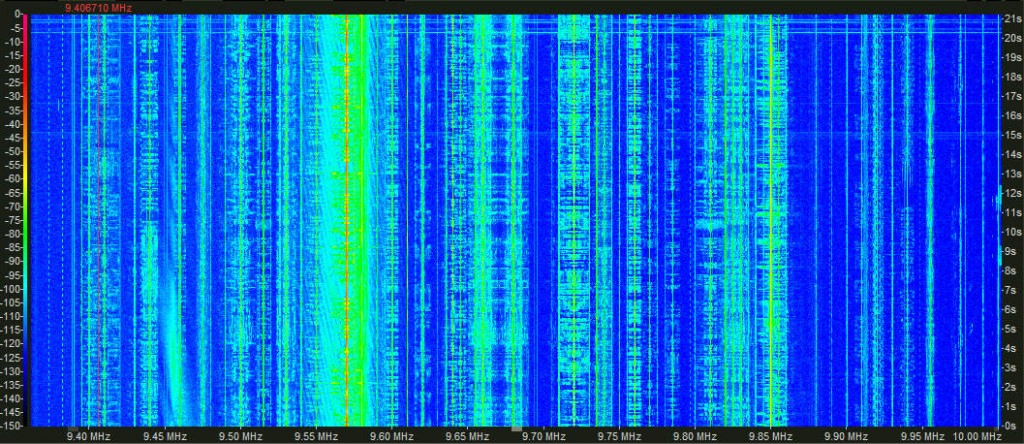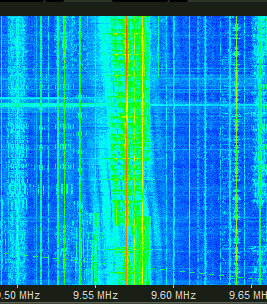 This morning, I tuned around the 31 meter band and was surprised with favorable propagation out of Asia (see spectrum waterfall above–click to enlarge).
This morning, I tuned around the 31 meter band and was surprised with favorable propagation out of Asia (see spectrum waterfall above–click to enlarge).
I started logging a few stations, but the effort quickly turned into a full band scan/survey. I logged everything I could easily hear between the 9,390-10,000 kHz portion of the 31 meter band.
I logged 52 stations and omitted eight that I considered too weak for good copy.
I used my WinRadio Excalibur SDR connected to a large horizontal delta loop wire antenna.
The number of broadcasts originating in or targeting China is pretty phenomenal: the 31 band is your oyster, if you speak Chinese.
31 Meter Band 1200 – 1300 UTC, all frequencies in kHz
- 9390 Radio Thailand Malaysian (1200Z) then English (1230Z)
- 9410 China National Radio 5 Chinese
- 9430 FEBC Radio Chinese
- 9440 China Radio International Cambodian
- 9460 China Radio International English
- 9475 Radio Australia English
- 9490 Voice Of America Korean
- 9500 China National Radio 1 Chinese
- 9515 China National Radio 2 Chinese
- 9530 Voice Of America Chinese
- 9540 China Radio International Chinese
- 9550 China Radio International Vietnamese (covered by CRI Cantonese distortion)
- 9570 China Radio International Cantonese (transmitter spewing distortion 50 kHz wide)
- 9580 Radio Australia English (covered by CRI Cantonese distortion)
- 9590 China Radio International Russian (covered by CRI Cantonese distortion)
- 9600 China Radio International English
- 9620 China National Radio 6 Chinese
- 9635 Voice of Vietnam 1 Vietnamese (slightly below freq)
- 9640 Radio Havana Cuba Spanish
- 9645 China Radio International English
- 9655 China Radio International Chinese
- 9660 Radio Taiwan International Chinese
- 9680 Radio Taiwan International Chinese
- 9700 Lower Sideband communication (UNID)
- 9710 China National Radio 1 Chinese
- 9720 China Radio International Filipino
- 9730 China Radio International English
- 9735 Radio Taiwan International Indonesian
- 9740 BBC English
- 9745 Guanghua zhi Sheng Chinese
- 9750 Radio Kuwait Arabic
- 9730 China Radio International English
- 9770 KBS World Radio Chinese
- 9775 China National Radio 2 Chinese (vy weak)
- 9785 China Radio International Laotian
- 9790 Voice Of Islamic Republic of Iran Pashto
- 9810 China National Radio 2 Chinese and All India Radio Telugu
- 9820 Radio Havana Cuba Spanish
- 9825 Voice Of America Chinese
- 9830 China National Radio 1 Chinese
- 9840 Voice of Vietnam English
- 9850 Radio Habana Cuba Spanish
- 9855 China Radio International Chinese
- 9860 China National Radio 1 Chinese (vy weak)
- 9880 KSDA-AWR Guam Korean (vy weak)
- 9900 Radio France International Chinese
- 9920 FEBC Radio Bahnar (w/Jamming)
- 9940 Reach Beyond Australia (HCJB) Indonesian
- 9955 Radio Slovakia International English (via WRMI/WRN)
- 9975 KTWR Guam Chinese
- 9990 Radio Farda Persian
- 10000 WWV Fort Collins English
I recorded two broadcasts during the scan–both at 12:30 UTC: Radio Thailand (9,390 kHz) and Radio Slovakia (9,955 kHz). I will post them soon.


Hello – I saw that you used a large horizontal delta loop in this listening session. I was wondering if you could provide some more information on it (height above ground, how many feet of wire, etc) and the question that I am most interested in getting an answer to – do you use an antenna tuner with it for your listening sessions? or does the feedline from the antenna go straight into your receiver? A lot of what I see on the internet are antennas for transmitting that make use of an antenna tuner to give a single antenna multiband capability and I am not sure if that is important in receive antennas as well. Thanks for your time.
I was on 31M this morning too Thomas. I was making a calibration graph for a coil I had just wound for the Sproutie specifically for the 31M band. I get coverage from 9280 to 10050, which is perfect. I must have heard most of the stations you heard, as I counted 49 calibration points. I wasn’t identifying them though, as I was simply using them as markers for calibration purposes. In some of the lower and middle parts of the band, there were stations every 5KHz! I also heard a very weak carrier at 9930KHz, though I’m not sure what it was.
Great listening, though it would have been perhaps a little more interesting if we spoke Chinese 🙂
Dave
AA7EE
It is amazing when a band really comes to life like 31M did this morning. The irony is, I could see that propagation was good via my SDR’s waterfall display. With with your home brew Sproutie regen receiver, it was pure discovery!
Thomas